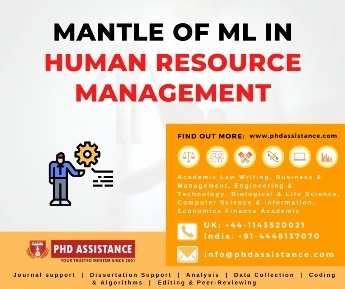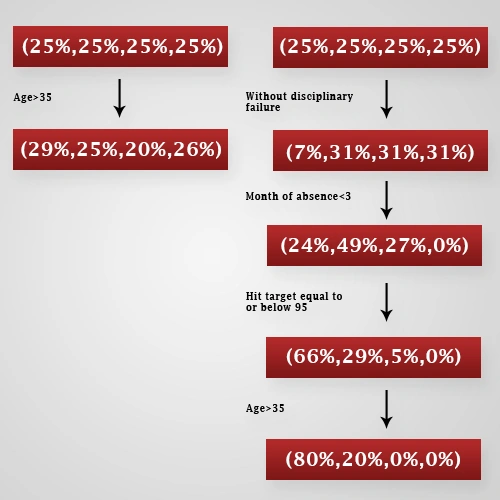How ML can be applied in PHD in Human resources Management dissertation?
In-Brief
- Transformation of HRM from normal execution to ML and AI algorithms’ implementations will clear the Organization’s growth’s bright path.
- HR functional components which have proved to be more effective and successful by integrating ML
- ML algorithms will improve the HR department’s performance, which will boost the entire Organization for efficient performance.

Introduction:
Today’s digital world requires, innovative HR implementation to improve employee performance and engagement. Recently HRM has been ascertained to join the league to more advanced headway like Artificial Intelligence (AI) and ML ( Machine Learning ). The presence of HRM in the Organization waves the employees’ performance to improve or maintain their stability. The transformation of HRM from Normal Execution to ML and AI algorithms’ implementations will clear the Organization’s growth’s bright path. 1
New Age HRM- Analytics to AI and ML
Machine Learning is a Solicitation of Artificial Intelligence programmed to access data to make predictions and give the required output without human interference.
To stimulate the regular presence of the Employee in an organization hits productivity and profitability. The objective-based gain measure system will understand and provide reliable concern for the Employee.2
The three major HR functional components which have proved to be more effective and successful by integrating ML are
- Recruitment and selection Management
- Performance Management
- Knowledge Management
The research article concludes that the integration of machine learning in HRM is highly efficient with specific functions like Decision trees, text-mining algorithms3
These algorithms will improve the HR department’s performance, which will boost the entire Organization for efficient performance.

- Recruitment and selection Management
The current trend demands a more comprehensive, more strategic perspective to recruit, utilize and conserve valuable human resources. Using algorithms like Classification and Regression will evaluate the candidate profile is legitimate and fit for the required job profile.
Recruitment is a process that determines the need for staffing for a particular position in the Organization and works to fulfill that need by identifying the right candidate for the job.
Machine Learning kickstarts the role of HRM by supporting and filtering the candidates based on some criteria. Based on the job posts, The candidates who will apply for the required job position can be screened using some denominations. Like, Age, Gender, Experience, Location, Skill sets, with cost-effectiveness (Figure 1). This approach is narrated through the article. 4

Figure 1. Relationship between age and absenteeism at an organization into different sub-groups of employees. The LHS indicates the simple partition of age and RHS expresses the series of pattern derived by the CART model. 4
ML assists organizations in sourcing the right candidate who meets their organizational goals by storing and managing a large mass of online applications.
The ML application designed to store applicants’ databases is also linked with various social media websites that provide additional information about the candidate.
This approach to recruitment and selection helps to recognize the right person for the right job and helps recruit at the right time by abbreviating the time required for the entire proceeding.
The work proposed by Irad Ben Gal and et.al 5 implies that a particular model for Pre-hire prediction of employees. This model enhances the high accuracy and interoperability of HR.
- Performance Management
After successfully recruiting the precise candidate for the job, the human resources department becomes liable to ensure that the Employee is utilized to his maximum capabilities and retained to serve the Organization long term. The results will deviate the contrast between well-performed candidates and Bad performed candidates. Based on the results, the HRM will act accordingly.
An organization’s success largely depends on its ability to identify, measure, and develop performance and, in turn, link each individual’s performance and objectives to the Organization’s overall mission and goals. Using Extreme Gradient Boosting (XG Boost) methodology will evaluate the Employee’s overall performance and efficiency. This methodology and concept is innovated by Rohit Punnose et. al 6.
Machine Learning Technology Software is to strengthen the Organization’s internal communications in the following ways.
- A centralized database helps keep track of individual contributions to organizational goals.
- ML encourages employee engagement in the Organization through feedback forms and chatbots.
- This application is available round the Clock for the Employee’s perusal.
- Automated rewards and appraisals designed to boost employee morale.
The article 7 prescribes a Gaussian Naïve Bayes classifier to annotates the performance of the employees of the Organization. It is used to filtrate the fillers or remarks if they occurred for the Employee.
- Knowledge Management
Many of the employees will quit the Organization due to a lack of knowledge and enhance their career knowledge. But sometimes, the reason may remain unknown, which leads to a hidden issue in the Organization. The article drives the Classification techniques like Support Vector Machines, Naïve Bayes, Random forests techniques to volume-up this issue. These classifiers filter and figure out the causation of termination or any other problems in the Organization.8
This technique augments individual learning for the employees and proves methodical to the Organization in a broad sense.
Acquire more knowledge in Artificial Intelligence, and Machine Learning Algorithms supports a lot in Knowledge management, enhancing the Skillset in all the management teams, which are mandatory for Human Resources and Management. The literature 9 kickstarts the KMC(Knowledge Management Capability), which positively maintains the frosty relationship between HRM and the entire Organization.
Table 1. Methodologies and Concepts of HRM using ML

Future Scope:
These are the Research Areas where the Machine Learning with respect to HRM is booming to core,
- Post-hire analysis process will enhance the exact requirement for the Organization based on the pre-hire analysis.
- ML with HRM is in the early stage. To establish more efficiency in the future, HR experts and ML specialists work together is mandatory.
- Using Machine learning algorithms with tools and languages will enhance the analytics process, improving organization production.
- Based on the performance, appraisal, incentives will be automatically generated to the HR and also the employees. If any escalation has appeared for the candidate, the reaction will be according to it.
Reference
- Zehir C., Karaboğa T., Başar D. (2020) The Transformation of Human Resource Management and Its Impact on Overall Business Performance: Big Data Analytics and AI Technologies in Strategic HRM. In: Hacioglu U. (eds) Digital Business Strategies in Blockchain Ecosystems. Contributions to Management Science. Springer, Cham.
- Singer, G.; Cohen, I. An Objective-Based Entropy Approach for Interpretable Decision Tree Models in Support of Human Resource Management: The Case of Absenteeism at Work. Entropy, 2020, 22, 821.
- Garg, Swati, Shuchi Sinha, Arpan Kumar Kar, and Mauricio Mani. “A review of machine learning applications in human resource management.” International Journal of Productivity and Performance Management(2021).
- Jagan Mohan Reddy, S. Regella and S. R. Seelam, “Recruitment Prediction using Machine Learning,” 2020 5th International Conference on Computing, Communication, and Security (ICCCS), Patna, India, 2020, pp. 1-4, doi: 10.1109/ICCCS49678.2020.9276955
- Dana Pesach, Gonen Singer, Dan Avrahami, Hila Chaulutz Ben Gal, Erez Shemuli, Irad Ben Gal. “Employees Recruitment: The prescriptive analysis approach via Machine learning and mathematical programming” (2020)
- Pankaj Ajit, Rohit Punnoose, “Prediction of Employee Turnover in Organizations using Machine Learning Algorithms” (2016)
- Fallucchi, Francesca, Marco Coladangelo, Romeo Giuliano, and Ernesto William De Luca. “Predicting Employee Attrition Using Machine Learning Techniques.” Computers 9, no. 4 (2020): 86.
- Anil Jadhav, “Churn Prediction of Employees Using Machine Learning Techniques” (2021)
- Hui Li, Mathida Khamkhoutlavong, Phong Ba Le, “Journal Of Knowledge management.”, (2021)



